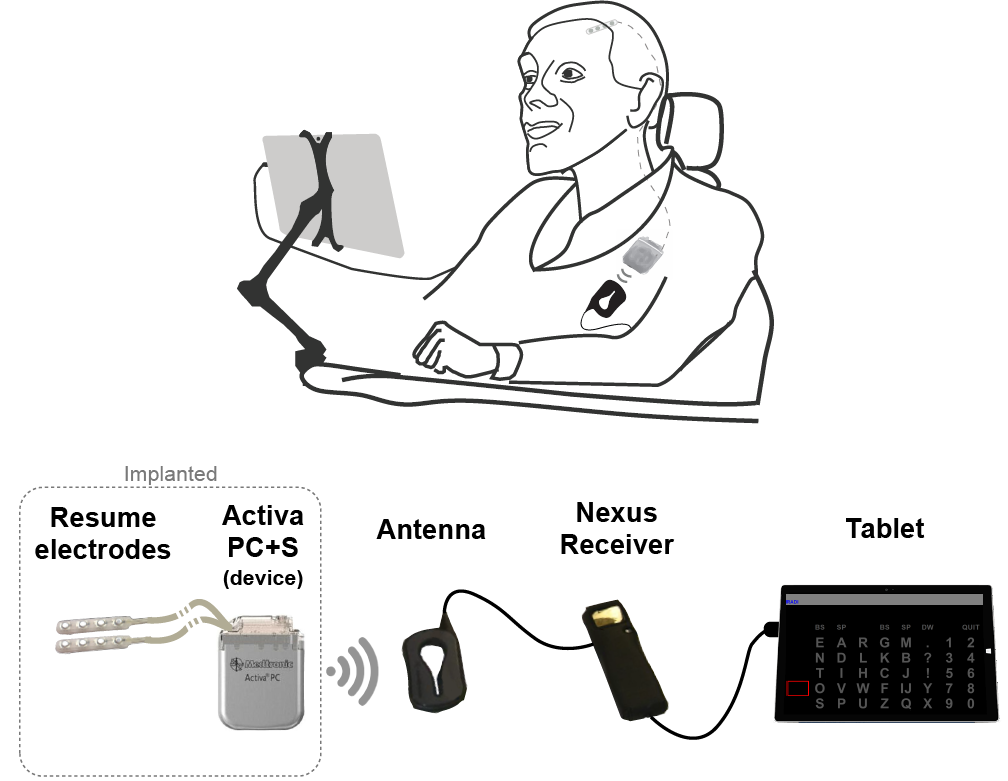Session Information
Date: Monday, June 5, 2017
Session Title: Quality Of Life/Caregiver Burden in Movement Disorders
Session Time: 1:45pm-3:15pm
Location: Exhibit Hall C
Objective: In people with movement disorder communication can be challenging and depends heavily on their caregiver. Here we describe an ALS-patient utilizing the first fully implanted Brain-computer Interface (BCI) for communication independently at home.
Background: A particular burdensome movement disorder is locked-in syndrome (LIS). Characterized by the loss of all voluntary movement LIS results in quadriplegia and the loss of speech, while cognition is intact. LIS has various causes, including brainstem stroke, trauma and ALS. Communication is a key aspect in the lives of these patients and the ability to do so is correlated with a high quality of life.
Methods: We developed a method for communication in LIS-patients based on a fully-implanted BCI. This system consists of subdural ECoG electrodes placed on top of the motor cortex and an amplifier/transmitter (Activa PC+S, Medtronic) placed subcutaneously in the left thorax. The signal is received wirelessly through the skin by an antenna and streamed to a tablet running signal processing software translating it to a control signal for spelling software (figure 1). A late-stage ALS patient (ALS-FRS-r: 3) was implanted with this system and has been using the BCI since late 20151
[figure1]
Results: The participant was able to use attempted hand movement as a control signal from the start. Independent control of a spelling computer was realized only 28 weeks after implantation. The participant is now using the system for >15 months and the signal and user-control remain stable and reliable as confirmed by 3 tasks: 1) Screening task (alternations of attempted hand-movement and rest): high correlation of control signal (65-95 Hz band power) with task conditions of 0.88, 2) High performance on a 1-dimensional cursor-control task (attempted movement for up, rest for down): 91±6% correct, 3) Baseline power of high frequency band stable from week 8 onwards 0.44±0.04a.u. The participant now uses the system independently at home, only requiring antenna placement by a caregiver, and reported high satisfaction.
Conclusions: Results indicate that (1) the motor cortex of people with movement disorder can be used to generate a reliable signal for BCI control, (2) the implanted electrodes are durable and information transfer is preserved over the course of 14 months, showing that an implanted BCI meets the needs of a user for an assistive communication device
References: 1. Vansteensel MJ, Pels EGM, Bleichner MG, Branco MP, Denison T, Freudenburg ZV, Gosselaar P, Leinders S, Ottens TH, Van Den Boom MA, Van Rijen PC, Aarnoutse EJ, Ramsey NF. Fully Implanted Brain–Computer Interface in a Locked-In Patient with ALS. N Engl J Med. 2016;375(21):NEJMoa1608085. doi:10.1056/NEJMoa1608085.
To cite this abstract in AMA style:
E. Pels, E. Aarnoutse, M. Vansteensel, S. Leinders, Z. Freudenburg, M. Branco, M. Vanden Boom, T. Denison, N. Ramsey. Implanted Brain-Computer Interface for communication in people with motor impairment [abstract]. Mov Disord. 2017; 32 (suppl 2). https://www.mdsabstracts.org/abstract/implanted-brain-computer-interface-for-communication-in-people-with-motor-impairment/. Accessed December 24, 2025.« Back to 2017 International Congress
MDS Abstracts - https://www.mdsabstracts.org/abstract/implanted-brain-computer-interface-for-communication-in-people-with-motor-impairment/

